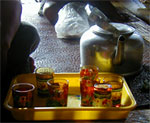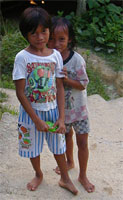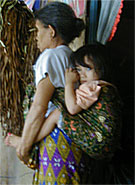
Page 1 | 2 | 3
"These days, the only headhunting that goes on around here is done
by employment agencies," jokes Cibu Nuyagang, a longhouse guide on the
Lemanak River. Like many of the guides on the river, Nuyagang was born
in a longhouse, then left it for the education and employment opportunities
in Kuching, Sarawak's capital city.  Having a native guide who understands
the language and the social complexities of the Iban helps a lot when it
comes to understanding life in a longhouse. Many westerners, for example,
are awkwardly surprised that complete strangers would host them for free
(out of courtesy, however, most people bring small gifts like candy for
the children). Having a native guide who understands
the language and the social complexities of the Iban helps a lot when it
comes to understanding life in a longhouse. Many westerners, for example,
are awkwardly surprised that complete strangers would host them for free
(out of courtesy, however, most people bring small gifts like candy for
the children).
"The Iban like visitors," explains Nuyagang. "It means that their house
is wanted. If nobody came, they would wonder why."
On nights when there are visitors, the Iban will typically peform traditional
dances and music, drink spicy rice wine (which can go to your head with
remarkable speed) then close off the evening by offering some handmade
crafts for sale. There is no obligation to buy anything, but the goods
made in the longhouse are almost always better and cheaper than similiar
items you'll see in the cities.
  Perhaps the best thing you can take away from a longhouse is not a
mask or a matt, however, but a bit of restored faith in humanity. People
here live communally, and they seem to have pulled off something akin to
a pastoral Marxist ideal. Divorce, for example, is a simple affair. When
it happens (which is almost never), there are no prolonged litigious proceedures,
no child-wrenching custody battles. The unhappy party simply infoms the
chief, gathers up his or her few possessions - a bundle of clothes, some
floor matts - then heads off to another room or back to their own
family's longhouse. Children stay with the mother, always. Perhaps the best thing you can take away from a longhouse is not a
mask or a matt, however, but a bit of restored faith in humanity. People
here live communally, and they seem to have pulled off something akin to
a pastoral Marxist ideal. Divorce, for example, is a simple affair. When
it happens (which is almost never), there are no prolonged litigious proceedures,
no child-wrenching custody battles. The unhappy party simply infoms the
chief, gathers up his or her few possessions - a bundle of clothes, some
floor matts - then heads off to another room or back to their own
family's longhouse. Children stay with the mother, always.
Kids are another remarkable aspect of longhouse life. You see them everywhere
- playing in the main hall, splashing about in the river - but rarely do
you hear them crying or fighting. They are amazingly contained and well-behaved,
a quality that some suggest comes from having a large and inclusive group
of adults always around.
 "Can you imagine
what this place would be like with ten western children running around
here," says Australian visitor Sue Berry as she watches a group of children
playing quietly in the main hall of a Lemanak longhouse. "It would be madness." "Can you imagine
what this place would be like with ten western children running around
here," says Australian visitor Sue Berry as she watches a group of children
playing quietly in the main hall of a Lemanak longhouse. "It would be madness."
Page 1 | 2
| 3
* * *
The Original Official Homepage
of the
Malaysia Tourism Promotion Board, New York

This page, and all contents
of this Web site are Copyright (c) 1996-2002 by interKnowledge Corp..
All rights reserved.
|
|

 Having a native guide who understands
the language and the social complexities of the Iban helps a lot when it
comes to understanding life in a longhouse. Many westerners, for example,
are awkwardly surprised that complete strangers would host them for free
(out of courtesy, however, most people bring small gifts like candy for
the children).
Having a native guide who understands
the language and the social complexities of the Iban helps a lot when it
comes to understanding life in a longhouse. Many westerners, for example,
are awkwardly surprised that complete strangers would host them for free
(out of courtesy, however, most people bring small gifts like candy for
the children).

 Perhaps the best thing you can take away from a longhouse is not a
mask or a matt, however, but a bit of restored faith in humanity. People
here live communally, and they seem to have pulled off something akin to
a pastoral Marxist ideal. Divorce, for example, is a simple affair. When
it happens (which is almost never), there are no prolonged litigious proceedures,
no child-wrenching custody battles. The unhappy party simply infoms the
chief, gathers up his or her few possessions - a bundle of clothes, some
floor matts - then heads off to another room or back to their own
family's longhouse. Children stay with the mother, always.
Perhaps the best thing you can take away from a longhouse is not a
mask or a matt, however, but a bit of restored faith in humanity. People
here live communally, and they seem to have pulled off something akin to
a pastoral Marxist ideal. Divorce, for example, is a simple affair. When
it happens (which is almost never), there are no prolonged litigious proceedures,
no child-wrenching custody battles. The unhappy party simply infoms the
chief, gathers up his or her few possessions - a bundle of clothes, some
floor matts - then heads off to another room or back to their own
family's longhouse. Children stay with the mother, always.
 "Can you imagine
what this place would be like with ten western children running around
here," says Australian visitor Sue Berry as she watches a group of children
playing quietly in the main hall of a Lemanak longhouse. "It would be madness."
"Can you imagine
what this place would be like with ten western children running around
here," says Australian visitor Sue Berry as she watches a group of children
playing quietly in the main hall of a Lemanak longhouse. "It would be madness."